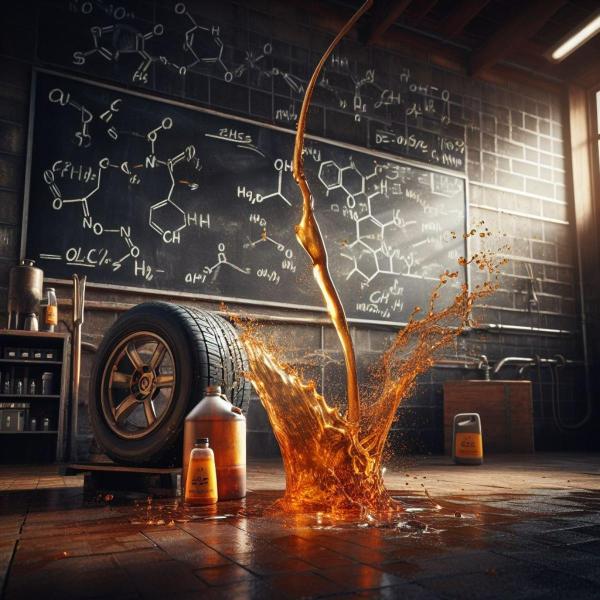As a mechanic, I’m occasionally asked to explain the difference between conventional and synthetic motor oil. With so many options out there to choose from, I recognize it can get confusing. In this article, I provide an in-depth look at how these two types of engine oils vary in their chemical composition and performance benefits.
Composition of Conventional Motor Oil
Conventional motor oils start with a base oil that is produced by refining crude oil through a process called fractional distillation. This separates the diverse mix of hydrocarbon compounds in crude oil based on differences in their boiling points.
Lighter fractions extracted include alkenes, cycloalkanes and aromatics ring structures with smaller carbon chains. Heavier base oil fractions contain larger cycloalkane and alkylated aromatic structures with higher boiling points.
This produces hydrocarbon molecules that vary greatly in their size, shape, weight and stability. Chains can contain anywhere from 15 up to 70 carbon atoms linked together. Variations in branching also impact properties.
Additives like detergents, dispersants, antioxidants, antiwear agents, pour point depressants, viscosity index improvers and more are blended into the base oil to achieve well-rounded performance. Each additive has a specific function.
Detergents keep deposits suspended – dispersants prevent clumping. Antioxidants neutralize free radicals from oxidation while antiwear additives form protective surface films. Pour point depressants keep oil fluid in the cold. Viscosity index improvers ensure viscosity is sufficient across temperature changes.
Basically, conventional motor oil is made by taking the diverse mix of hydrocarbon compounds in crude oil and fractionating them by boiling points into an inherently variable base oil, then customizing it with additives to meet viscosity, lubrication, cooling and cleaning needs inside modern engines.
Composition of Synthetic Motor Oil
While conventional oils rely on the innate variability of crude oil fractions, synthetics are produced through deliberate chemical synthesis to achieve uniformity in molecular chains. The goal is consistency in properties like volatility, viscosity index, oxidation resistance and flow at extreme temperatures.
Common routes include reacting purified petroleum derivatives like decene with catalysts using heat and pressure to polymerize or chain extend molecules of a specific size and shape. Polyalphaolefins (PAOs) made this way have consistent hydrocarbon chains around 40 carbon atoms long with very little branching.

Another route is to polymerize specific monomers using metallocene catalysts to form even narrower molecular weight distributions. Esters like polyol esters can also be tailored to have desirable stability, lubricity and polarity. Gas-to-liquid base oils offer another approach to precisely tuned hydrocarbons.
Additives can then supplement the inherent performance of the synthesized base oils. But the uniform base stock itself flows evenly across high and low temperatures while resisting volatility and oxidative degradation. Conventional oils need more help in these areas.
In essence, while conventional oils use the existing diversity in crude itself, synthetic oils are built from the molecular level up to have uniform chains that enable inherent stability, viscosity performance and cleaner burning over wide operating conditions.
Base Oil Groups
Here is an explanation of the five base oil groups categorized by the American Petroleum Institute (API):
- Group I base oils are the least refined of all the groups. They are produced by solvent extraction and consist of fractions of crude oil that require the least amount of processing to meet the API 1509 specifications. Group I base oils contain more impurities which can negatively impact performance.
- Group II base oils are more highly refined than Group I through additional processes like hydrotreating. This removes impurities, resulting in improved oxidation stability while maintaining good performance at low temperatures.
- Group III base oils are the most highly refined. They undergo the most intensive hydroprocessing which converts undesirable molecules into preferred isoparaffins. This ultra-purification gives Group III exceptional performance capabilities.
- Group IV base oils are made by chemically altering the final structure of Group I to III base oils through a process called polyalphaolefin (PAO). This produces pure synthetic hydrocarbons with uniform molecular chains and consistent physical properties.
- Group V includes all other base oils not included in Groups I-IV like naphthenics, polyol esters, bio-based oils etc. They can be petroleum or synthetic in origin .

Performance Differences
When it comes to protecting and lubricating engines, not all motor oils are equal. Synthetic oils offer improved performance in several areas:
Thermal Stability
One of the main purposes of motor oil is to maintain proper viscosity and flow characteristics at all engine operating temperatures. As temperature increases, the viscosity of a fluid normally decreases and flows thinner – this is called thermal thinning. The opposite effect happens at cold temperatures when oil thickens up – known as thermal thickening.
These changes in viscosity can be problematic. When oil gets too thin, it may not be able to properly lubricate and protect vital engine components. If it thickens excessively when cold, the oil can strain the starting system and result in poor lubricity.
Conventional motor oils are made of diverse hydrocarbon chains with variability in molecular weight and structure. This diversity means viscosity breaks down more quickly at extreme high and low temperatures. Additives help counteract thinning and thickening, but only to a degree.
Synthetic oils have uniform molecular chains engineered to resist thermal stress. At cold startup temperatures, synthetic oils flow much more easily than conventional oils, circulating faster to reduce wear. Under intense heat, the molecular bonds in synthetics are less likely to break down, maintaining better protection and lubrication compared to conventional oils.
Overall, the innate thermal stability and strength of the synthesized hydrocarbon chains used in synthetic oils allows them to maintain viscosities and lubricating capabilities closer to optimum levels despite wide temperature swings. Conventional oils are more prone to surpassing ideal viscosity ranges. Proper viscosity directly impacts engine protection and efficiency. So synthetics have an inherent performance advantage.
Reduced Friction
The key purpose of motor oil is keeping metal engine components from making direct contact under load and motion. The oil molecules literally stand in between the metal surfaces to act as a lubricating film. This prevents friction, which would lead to rapid wear and engine damage.

Under the intense pressures inside an engine, a process called boundary lubrication occurs at the most loaded contact points. This is where the lubricating film becomes the thinnest. The actual oil molecules interact with and adhere to the metal through absorbed layers and chemical bonding.
Synthetic oils are engineered with molecule chains that readily form these tenacious absorbed boundary layers more effectively. The uniform shape, size and polarity of synthetic oil molecules allows them to tightly pack and align on metal surfaces. This creates a durable boundary film to separate parts.
Conventional oils contain less uniform molecules that can shear off under load, opening the door for metal-metal contact. The optimized molecular makeup of synthetic oils resists shearing stress better within the absorbed boundary layer itself. Plus, their slicker body helps prevent or minimize direct surface friction in the first place.
Through robust boundary film formation and smoother lubricity, synthetic oils outperform at reducing friction. Less friction equals less wear over time – providing longer lasting protection between tune ups while minimizing cumulative engine damage from the extreme pressures inside.
Cleanliness
All motor oils experience oxidation and thermal breakdown over time and use, which degrades the oil molecules. The byproducts of this oil degradation are contaminants like sludge, varnish, and carbon deposits.
These oil contaminants can clog narrow passages, stick on hot spots forming hot spots, foul sensors and moving parts, and reduce heat transfer. This buildup of deposits leads to reduced engine efficiency and performance.
Conventional motor oils contain diverse hydrocarbon chains with weaknesses that are attacked under heat, oxygen exposure, and mechanical stress inside engines. Cracked molecules combine into oligomers and insoluble particulates that contribute to sludge.
In contrast, the uniform molecular chains in synthetics are extremely resistant to thermal/oxidative degradation as well as mechanical shear forces. Their stable state prevents contaminating byproducts from building up internally.
To visualize this, you can think of breaking cooked spaghetti noodles in half versus trying to break uncooked noodles – the stiff uncooked ones stay rigid. Similarly, conventional oil molecules break whereas synthetic oil molecules remain intact.
By resisting decomposition into deposit-forming contaminants, synthetic oils maintain cleaner engines for longer. Detergent additives help limit deposit issues in all oils. But sludge and varnish issues are inherently minimized in synthetics due their innate thermal/oxidative stability under stress.
Longer Drain Intervals
The key factor limiting oil drain intervals is the condition and protective capability of the oil over time and mileage. As contamination builds up and viscosity breaks down, oil loses its ability to properly lubricate and shield engines from wear and damage. This is what necessitates oil changes.
Conventional motor oils are inherently more vulnerable to permanent viscosity loss from Noack volatility as well thermal thinning and thickening issues. Their diverse hydrocarbon chains also readily succumb to oxidation, nitration, and mechanical shear forces – transforming into sludge, acids, and insoluble particulates.

In contrast, synthetic motor oils better withstand heat/stress without significant viscosity loss or contamination buildup. Their uniform synthetic hydrocarbon chains resist breakdown into deposit-forming byproducts. Plus they are optimized to maintain ideal viscosities across wide temperature ranges for longer.
In essence, the improved stability and durability of synthetic base oils allows their lubricating properties to hold up better over extended oil drain intervals before needing to be changed out. Their superior chemistry withstands the mechanical and thermal stresses inside an engine for prolonged periods without loss of function.
Top tier conventional oils may be finely tuned through additives to enable longer intervals as well. But synthetics have an inherent formulation advantage in resisting viscosity loss, thermal stress, and contamination issues that necessitate oil changes in the first place. This allows them to reliably extend the interval between services.
While more expensive upfront, synthetic oils make up for the price difference through longer drain intervals and reduced likelihood of wear on high mileage engines. They excel at extreme temperatures and heavy loads compared to conventional oils. Both varieties use additives to achieve desired performance standards. But synthetic base oils offer advantages from the start.
Hopefully this overview gives helpful clarity into the chemical and practical differences between conventional and synthetic motor oils. Please let me know if you have any other questions!
Which is Better?
Both conventional and synthetic oils have pros and cons that make them well suited for specific applications and situations.
In many ways, synthetics outperform conventional oils due to their precisely tuned molecular structure – they flow better at extreme temperatures, resist breakdown and viscosity loss, keep engines cleaner, protect against wear at high loads, and support longer drain intervals. However, as we all know, they also tend to be more expensive.
For consumer vehicles under normal driving conditions, quality conventional oils provide sufficient protection and performance for thousands of miles if changed regularly. The additives blended into refined crude oil base stocks enable well-rounded lubrication, though not to the extent of inherent synthetics benefits.
For racing applications or extreme cold/hot climates, synthetics offer clear advantages. Their stable base oils and ability to sustain viscosity and flow gives them an edge in harsh conditions. Cost becomes less important with high performance engines.
Just Answer the Question!
At the end of the day, and as we’ve seen, there are a variety of factors you must consider when choosing an oil including: vehicle make/model specs, driving behavior, climate and maintenance habits. Both Conventional and Synthetic oils have good and bad points. If price is not a factor, then I can just about universally recommend synthetics over conventional oils as the definitive “better” oil.
That being said, it is important to note that an objective expert considers the tradeoff based on facts instead of general claims.
This seems to be a topic that garners a lot of passionate feelings, let us know your thoughts in the comments.

